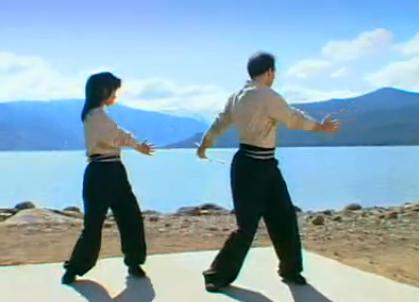

Hi Kato!
Thanks a lot
for those video clips.
From: diane03760@vancouver.ca
To: barclay1720@aol.com
Date:Wed, May 18, 2011 4:47 pm.
Hi Kato,
Thanks so much .. this is all so very interesting.
One of these days I'm going to take a chi gong (気功) class here at the WECC(Westend Community Centre).

I remember taking one years ago.
In the meantime, I do my yoga every day.
and have done for years.
I used to be a yoga teacher.


I go to the gym three times a week,
walk the seawall with my group every Tuesday
and swim and hike in the mountains when I get the chance.




Hopefully, this will keep me in shape for years to come!

Thomas Jefferson, one of the early USA Presidents (he penned the Declaration of Independence) and who was a very learned man, said that "every man should devote his afternoons to exercise and recreation as it is as important as reading."
In fact, he said, "It's even more important because our health is worth more than learning."
That's for sure!
He impressed me.
Of course, learning is important, too ... but who's got the time for everything?!
Thanks again for these video clips.
They're wonderful.

Love, Diane ~
SOURCE: "Yoga and Happiness"
(May 22, 2011)

Kato, how come you've brought up my old mail?

You used to be a yoga teacher, and now you're taking a chi gong (気功) class.
Yes, I am.
No wonder you're in a good shape. And I'm pretty sure you'll be in shape for years to come.

You are in
a good shape!


I really hope so.

what kind of lesson are you taking in the class?
I'll show you in the following video.

(chigong90.jpg)

Wow! ... quite mysterious movements...like those of Tai chi.
Tai chi (太極拳)
T'ai chi ch'uan (simplified Chinese: 太极拳; traditional Chinese: 太極拳), often shortened to T'ai chi or Tai chi in the West, is a type of internal Chinese martial art practiced for both its defense training and its health benefits.
It is also typically practiced for a variety of other personal reasons: its hard and soft martial art technique, demonstration competitions, and longevity.
As a consequence, a multitude of training forms exist, both traditional and modern, which correspond to those aims.
Some of t'ai chi ch'uan's training forms are especially known for being practiced at what most people categorize as slow movement.
Today, t'ai chi ch'uan has spread worldwide.
Most modern styles of t'ai chi ch'uan trace their development to at least one of the five traditional schools: Chen, Yang, Wu/Hao, Wu, and Sun.
The term t'ai chi ch'uan translates as "supreme ultimate fist", "boundless fist", "great extremes boxing", or simply "the ultimate."
Note that chi in this instance is the Wade-Giles transliteration of the Pinyin jí, and is distinct from qì (or chi 氣), which means "life energy".
The concept of the Taiji ("supreme ultimate") appears in both Taoist and Confucian Chinese philosophy, where it represents the fusion or mother of Yin and Yang into a single Ultimate, represented by the Taijitu symbol.
T'ai chi theory and practice evolved in agreement with many Chinese philosophical principles, including those of Taoism and Confucianism.
T'ai chi training involves five elements, nei gung, tui shou (response drills), sanshou (self defence techniques), weapons, and solo hand routines, known as forms (套路 taolu).
While t'ai chi ch'uan is typified by some for its slow movements, many t'ai chi styles (including the three most popular - Yang, Wu, and Chen) have secondary forms of a faster pace.
Some traditional schools of t'ai chi teach partner exercises known as "pushing hands", and martial applications of the forms' postures.
SOURCE: "T'ai chi ch'uan"
Wikipedia, the free encyclopedia

Kato, why don't you join my class? You could improve your health. You know, Kato, health is worth more than learning.

I know...I know...I will join your class some day.
You always say that, but your "some day" seems 100 years down the road.
But Diane, you said who's got the time for everything, didn't you? I don't have the time for everything.
I know. It seemes to me that you're always writing articles in the library. When you are not writing, then you're watching DVDs. Writing and learning is important, but, as Thomas Jefferson said, every man should devote his afternoons to exercise and recreation as it is as important as reading, learning, and writing.
You sounds like my teacher in the elementary school.
Take my advice, Kato, and join my class, will you?
Yes, yes, yes,... some day, but actually, I'm a Zen practitioner. When I've got some spare time, I always practise Zen.
Zen is quite static to me.
Static to you, Diane?
Yes, it is. Not dynamic, I mean, Zen is doing nothing---sitting still. I don't know how it could possibly improve your health and mind.
Have you ever heard of Bodhidharma?
Yes, you told me about him the other day.
Bodhidharma
達磨(ダルマ)

Bodhidharma was a Buddhist monk who lived during the 5th-6th century and is traditionally credited as the leading patriarch and transmitter of Zen to China.
According to Chinese legend, he also began the physical training of the Shaolin monks that led to the creation of Shaolinquan. However, martial arts historians have shown this legend stems from a 17th century chigong manual known as the Yijin Jing.
Little contemporary biographical information on Bodhidharma is extant, and subsequent accounts became layered with legend, but most accounts agree that he was a Tamil prince from southern India's Pallava Empire. Scholars have concluded his place of birth to be Kanchipuram in Tamil Nadu.
After becoming a Buddhist monk, Bodhidharma traveled to China. The accounts differ on the date of his arrival, with one early account claiming that he arrived during the Liú Sòng Dynasty (420–479) and later accounts dating his arrival to the Liáng Dynasty (502–557). Bodhidharma was primarily active in the lands of the Northern Wèi Dynasty (386–534). Modern scholarship dates him to about the early 5th century.
Throughout Buddhist art, Bodhidharma is depicted as a rather ill-tempered, profusely bearded and wide-eyed barbarian. He is described as "The Blue-Eyed Barbarian" in Chinese texts.

The Anthology of the Patriarchal Hall (952) identifies Bodhidharma as the 28th Patriarch of Buddhism in an uninterrupted line that extends all the way back to the Buddha himself. D.T. Suzuki contends that Zen's growth in popularity during the 7th and 8th centuries attracted criticism that it had "no authorized records of its direct transmission from the founder of Buddhism" and that Zen historians made Bodhidharma the 28th patriarch of Buddhism in response to such attacks.
SOURCE: Wikipedia
PICTURES: from the Denman Library

He looks like a devil to me---a quite scary man, wasn't he?


Yes, he was in a sense. He is actually depicted as a rather ill-tempered, profusely bearded and wide-eyed barbarian.

So what was he good at?
In Japan, Bodhidharma is believed to be an original grand Zen master.
Oh, is he?
He is known as "Daruma" in Japan, and every Japanese knows about him. If anybody doesn't know about "Daruma" in Japan, he or she is NOT a Japanese.
Is he that famous in Japan?
You bet on that, Diane. In Japan, almost every household used to have a "Daruma" figure in an alcove or on a shelf.


Is this the "Daruma" figure?

Yes, it is.
How come it has only one black eye---not two black eyes?
A good question, Diane...'cause the Japanese usually buy a "Daruma" figure with no black eyes.


When you have a serious wish, then you would pray to Daruma while writing a black eye on his face.


Once your wish is realized, then you will paint another black eye.


And then the "Daruma" figure will become your full-fledged talisman.

Quite interesting! So his teaching is well-known in Japan, isn't it?
Oh yes, it is.
...like what?
For example, the following teaching is written in one of famous Zen scripts.
無為無事の人
(Be born-free again)

It literally means "a man who does nothing and gets involved in nothing."

...doesn't make sense to me.
I know what you mean, Diane...Zen scripts often sound meaningless, if not self-contradictory.
Doing nothing and remaining involved in nothing means that you're born-free again. Is that it?
You see, Diane, some people are preoccupied by their status in our society in terms of family ancestory, wealth, education, and so on. Bodhidharma told his disciples to throw away those superficial goodies, which would prevent them from seeing the truth of life.
I see.
One of his diciples said, "Master, I'm free from all the goddies." Then Bodhidharma said to him, "No, you are not...'cause you're even chained by your belief of being free from all the goddies."
So Bodhidharma was a very sarcastic person, wasn't he?

Yes, Diane, you're telling me. Once Bodhidharma went too far.
In what way?
Sitting still, Bodhidharma faced the rock wall for nine years.
Well, that's not so extraordinary, Kato...'cause, in our Christian history, one of the saints lived on the top of the pillar for more than 30 years.
Saint Simeon

Saint Simeon Stylites or Symeon the Stylite (c. 390 – 2 September 459) was a Christian ascetic saint who achieved fame because he lived for 39 years on a small platform on top of a pillar near Aleppo in Syria.
Several other stylites later followed his model (the Greek word style means pillar).
He is known formally as Saint Simeon Stylites the Elder to distinguish him from Simeon Stylites the Younger and Simeon Stylites III.

Yes, I know that, Diane...I learned about him in the European history. However, one of Bodhidharma's disciples went much too far.

In what way?


While Bodhidharma was facing the rock wall, Huike (慧可:えか) visited him and asked the grand master to teach him. Bodhidharma initially refused to teach Huike.

I suppose, Huike didn't give up, did he?
No, he didn't. Huike stood in the snow outside Bodhidharma’s cave all night until the snow reached his waist. In the morning Bodhidharma asked him why he was there and Huike replied that he wanted a teacher to "open the gate of the elixir or universal compassion to liberate all beings".
Then what did the grand master say?
Bodhidharma refused, saying, “how can you hope for true religion with little virtue, little wisdom, a shallow heart, and an arrogant mind? It would just be a waste of effort.” Finally, to prove his resolve, Huike cut off his left arm and presented it to the First Patriarch as a token of his sincerity at which point Bodhidharma accepted him as a student and changed his name from Shenguang to Huike (“Wisdom and Capacity”).
My goodness! ... Huike went too far.
The story continies, Diane. Without realizing that he had just self-amputated his left arm, Huike screamed in pain and then said to Bodhidharma, “My mind is anxious. Please pacify it.” Bodhidharma replied, “Bring me your mind, and I will pacify it.” Huike said, “Although I’ve sought it, I cannot find it.” “There,” Bodhidharma replied, “I have pacified your mind.”
I see...What a sarcastic master Bodhidharma was! So, an anxious mind didn't exist in the first place, did it?
You're right on, Diane.
But, Kato, what are you practising?
A good question! While I sit still, I'm trying not to have an anxious mind. This practice indeed improves my health and mind---much more than devoting my afternoons to exercise and recreation.

【Himiko's Monologue】

Wow! ... what an extreme life style!
Can you believe that a man could live on the pillar for 39 years?
Do you really believe that a man cut off his left-arm to show his sincerity?
As you know, I desperately want to meet my better half.
But when I meet a man like Saint Simeon or Huike, and he proposes to marry me, I'd rather remain single.
In any case, I've never met my "Romeo"---a decent man in my life.
How come I'm always a loner?
I wish I could meet a nice gentleman at the library in my town as Diane met Kato.
Well, they say, there is a way where there is a will.
I hope Kato will write another interesting article.
So please come back to see me.
Have a nice day!
Bye bye ...


If you've got some time,
Please read one of the following artciles:

■"Hello Diane!"
■"I wish you were there!"
■"Jane Eyre"

■"Jane Eyre Again"
■"Jane Eyre in Vancouver"
■"Jane Eyre Special"
■"Love & Death of Cleopatra"
■"Nice Story"

■"Scrumdiddlyumptious"
■"Spiritual Work or What?"
■"What a coincidence!"

■"Wind and Water"
■"Yoga and Happiness"
■"You're in a good shape"

■"Hellelujah!"
■"Ecclesiophobia"
■"Uncorruptible"
■"Net Travel & Jane"

■"Net Love"
■"Complicated Love"
■"Electra Complex"
■"Net Début"
■"Inner World"

■"Madame Riviera and Burger"
■"Roly-poly in the North"
■"Amazing Grace"
■"Diane in Paris"
■"Diane in Montmartre"

■"Diane Well Read"
■"Wantirna South"
■"Maiden's Prayer"
■"Bandwidth"
■"Squaw House and Melbourne Hotel"

■"Tulips and Diane"
■"Diane in Bustle Skirt"
■"Diane and Beauty"
■"Lady Chatterley and Beauty"
■"Victoria Prudery"

■"Diane Chatterley"
■"From Canada to Japan"
■"From Gyoda to Vancouver"
■"Film Festival"
■"Madame Taliesin"
■"Happy Days"
■"Vancouver Again"
■"Swansea"

■"Midnight in Vancouver"
■"Madame Lindbergh"
■"Dead Poets Society"
■"Letters to Diane"
■"Taliesin Studio"

■"Wright and Japan"
■"Taliesin Banzai"
■"Memrory Lane to Sendai"
■"Aunt Sleepie"
■"Titanic @ Sendai"
■"Birdcage"
■"Roly-poly in the wild"
■"Silence is dull"


Hi, I'm June Adames.
You might wonder why Saint Simeon decided to live on the top of the pillar.
Well...an ever-increasing number of people came to see him for prayers and advice.
This left him little if any time for his private austerities.
So he decided to climb up the pillar and formed a small platform at the top so that he could remain undisturbed.
Since he couldn't escape the world horizontally, he tried to escape it vertically.
For sustenance, small boys from the nearby village would climb up the pillar and pass him small parcels of flat bread and goats' milk.
In any case, to an ordinary man, living at the top of pillar is unthinkable.
If you determine to do the same nowadays, you are more than likely to be considered as the most foolish person in the world.


ところで、愛とロマンに満ちた
レンゲさんのお話をまとめて
『レンゲ物語』を作りました。
もし、レンゲさんの記事をまとめて読みたいならば、
次のリンクをクリックしてくださいね。
■『愛とロマンのレンゲ物語』

■『軽井沢タリアセン夫人 - 小百合物語』
とにかく、今日も一日楽しく愉快に
ネットサーフィンしましょうね。
じゃあね。







0 件のコメント:
コメントを投稿